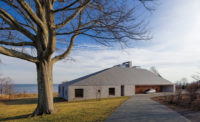First Look: Rick Joy's Princeton Train Station














The project is part of a massive redevelopment of the southwest corner of the Princeton campus; its centerpiece will be a 140,000-square-foot arts center by Steven Holl Architects. Assembling the site for that center required the University to relocate both the station and a neighboring WaWa convenience store. Joy was hardly the obvious choice for the job, given that he is best known for designing crisply geometric houses, most of them in the Sonoran Desert. But the commission did require him to work at a domestic scale.
Along with the station, Joy, the founder of Rick Joy Architects, designed several adjacent structures, including a new WaWa, which has to be the most sophisticated convenience store ever. It doesn’t soar like the station, but it repeats many of the same materials and moves. Together with a bike shed, and a canopy over the railroad platform, both of blackened stainless steel, the two buildings create a handsome ensemble (a kind of miniature Princeton quadrangle) around a bluestone plaza.
But the train station is the focus. Working from a simple brief, Joy created a sculptural building that looks different from every angle. Inside, amenities include wooden benches made by the studio of George Nakashima—hardly low-budget items. At an Architectural Record conference last fall, Joy said, "The Princeton project is a thrill," adding that it "is probably going to spoil me.”









